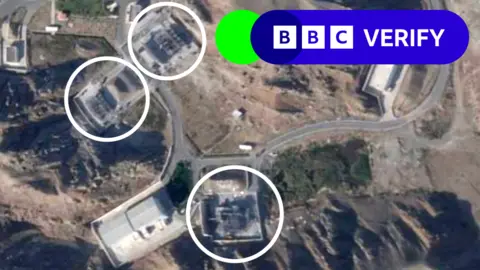What Satellite Images Reveal About Israel’s Strikes on Iran
What Satellite Images Reveal About Israel’s Strikes on Iran: A Closer Look
In recent weeks, tensions between Israel and Iran have escalated, with reports of Israeli airstrikes targeting critical infrastructure in Iran. The geopolitical friction between these two countries has a long history, but the latest developments have drawn global attention. To understand the impact of these strikes, BBC Verify conducted a detailed analysis of satellite imagery, revealing the extent of the damage and providing insights into Israel’s strategic operations in Iran.
The Rising Tensions and Military Confrontation
The Israeli-Iranian conflict has intensified due to various geopolitical factors, including Iran’s nuclear ambitions and Israel’s commitment to curbing Tehran’s regional influence. As these tensions boil over, both nations have increasingly leveraged their military might. Israel has a track record of covert operations and airstrikes targeting Iran’s nuclear facilities and arms depots. However, the recent strikes have raised eyebrows due to their precision and apparent strategic importance.
Analyzing Satellite Images: Uncovering the Damage
According to BBC Verify, satellite images analyzed from key locations in Iran suggest that Israel’s strikes were not random. They seem to have been carefully planned and executed to target vital infrastructure. The images provide insight into several aspects of these attacks, revealing damage to multiple facilities linked to Iran’s military and nuclear programs.
Key Findings from the Satellite Imagery
- Precision Targeting of Military Facilities
The satellite images show that the strikes were not indiscriminate; rather, they were focused on specific military installations and arms depots. Several buildings and compounds in Iran that were believed to house weapons and critical equipment have been damaged or destroyed. Analysts pointed out signs of scorched grounds and debris, indicating that high-explosive missiles were likely used in these attacks. - Impact on Iran’s Air Defense Systems
Another significant revelation from the satellite analysis is the damage inflicted on Iran’s air defense systems. Israeli airstrikes appear to have targeted radar installations and missile systems. This strategic move could be aimed at weakening Iran’s air defense capabilities, allowing Israel to conduct future operations with fewer risks of retaliation. - Strikes on Sensitive Nuclear Facilities
The most concerning revelation is the apparent damage to certain facilities associated with Iran’s nuclear program. Although the exact nature of these sites is still classified, satellite imagery suggests that the strikes targeted key buildings suspected of housing centrifuges or other critical components. This adds to speculations that Israel is intensifying its efforts to disrupt Iran’s nuclear ambitions.
Strategic Intent Behind Israel’s Strikes
The satellite imagery highlights a pattern in Israel’s military strategy against Iran. By targeting military installations, air defenses, and potentially nuclear facilities, Israel appears to be taking proactive measures to degrade Iran’s military and nuclear capabilities. This aligns with Israel’s long-standing policy of preventive action, aimed at ensuring that Iran does not pose an existential threat.
The Role of Satellite Analysis in Modern Warfare
Satellite imagery has become an indispensable tool in modern warfare and international surveillance. Governments, media outlets, and intelligence agencies often rely on satellite data to verify claims and assess damage in conflict zones. In the case of Israel’s strikes on Iran, BBC Verify utilized high-resolution imagery from commercial satellite providers to independently assess the situation on the ground.
Such imagery not only provides visual evidence but also helps analysts understand the scale of the damage and the strategic implications of military actions. The accuracy of satellite images can help in holding conflicting parties accountable and in validating the claims made by governments or military forces.
Iran’s Response and International Implications
Iran has yet to officially disclose the full extent of the damage, but it has condemned Israel’s actions, labeling them as acts of aggression. Tehran has promised retaliation, heightening concerns about further escalation in the region. The Iranian government claims that the attacks are part of a broader strategy to destabilize the country and curb its influence.
On the international front, these strikes have stirred global powers into action. The United Nations and key stakeholders, such as the United States and European Union, are closely monitoring the situation. Israel’s bold moves have sparked debates about the potential for a broader conflict that could have severe ramifications across the Middle East.
Why the World Should Take Note
Israel’s strikes on Iran are not isolated incidents but part of a broader geopolitical chess game in the Middle East. As both nations engage in a dangerous game of brinkmanship, the potential for a larger conflict looms over the region. The revelations from satellite imagery offer a glimpse into the scale of Israel’s operations and the stakes involved.
Understanding the implications of these strikes is crucial for grasping the delicate balance of power in the Middle East. If the situation escalates, it could trigger a chain of events affecting global oil markets, international security, and regional alliances.
Conclusion: A High-Stakes Conflict in the Middle East
The satellite imagery analyzed by BBC Verify paints a stark picture of Israel’s latest strikes on Iran. The precision and scale of the damage indicate that Israel is stepping up its efforts to curb Iran’s military capabilities and nuclear ambitions. As tensions continue to escalate, the world watches closely to see how both nations navigate this precarious situation.
For now, Israel’s strikes have left a significant mark on Iran’s infrastructure, sparking renewed concerns about the future of Middle Eastern geopolitics. With both nations unwilling to back down, the coming weeks and months could be critical in shaping the future of the region.
Discover more from NewsPour
Subscribe to get the latest posts to your email.




Let your voice be heard! Share your thoughts and ignite discussions.